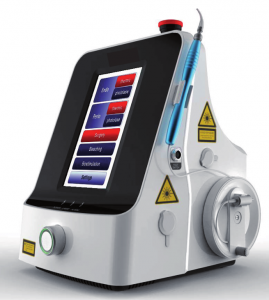To destroy pathogenic germs with selective local infections without systemic side effects, while promoting wound healing is the goal in the modern day minimally invasive antimicrobial medicine. Finally, so-called by an increasing proliferation. Multiresistant germs, it has become increasingly difficult in recent years to achieve this goal with the use of antibiotics. A local application of such drugs can be problematic due to the possibility of allergia symptom and due to selective action spectra is the possibility of so-called superinfection. When administered systemically to local infection therapy are not uncommon side effects inevitable to generate a sufficiently high drug levels. The penetration properties of these agents may also be limited by “leucocytic screening” or poor perfusion. So the interest in alternative methods for local infection treatment in recent years has increased significantly. One possibility is the so-called antimicrobial photodynamic therapy (aPDT).
The effect of this therapy is based with the fact that by the irradiation of specific dyes (so-called sensitizers). monochromatic and z.T generated coherent light sources in conjunction with molecular oxygen briefly radicals called reactive oxygen species (ROS). These radicals are, under certain conditions capable of membranes eg of bacteria and fungi to destroy damaging by redox reaction without healthy tissue and thus bactericidal, fungicidal but partly also to unfold virucidal effects or even destroy protozoa. This requires not only a high affinity of the sensitizer to the corresponding membrane structures, a sufficient concentration of the dye at the scene and exciting light sources with a precisely tailored to the particular sensitizer wavelength. At the same time specific light doses to be given at specific time intervals to an efficient energy transfer from the excited dye to the oxygen and thus to allow a sufficient yield of ROS.
Conventional aPDT process must sensitizers before irradiation usually dilute your target chromophore to achieve ever (Law by Lambert Beer). This necessary procedure deteriorated but also the absorption and thus the yield of ROS. To compensate for this disadvantage then you need high light output for photodynamic processes. In these systems, however, must be exposed to relatively low light output levels in order to avoid so-called. Photobleaching effects which in turn make long exposure times necessary to reach photodynamic processes. The wavelengths used these techniques are often in the UV-VIS range. That means a very limited light penetration into vital tissue of a few millimeters.
With the new Photolase® process it has become now possible to develop for the first time a aPDT procedures that in the near infrared wavelength 810nm works with. It thus enables a light penetration depth of up to 4 cm whereby radiation over long distances is possible. Through intensive research, supported by quantum physicists and pharmacologists / microbiologists and medical scientists have succeeded in changing a specific sensitizer on Phenothiazinbasis so that efficient absorption with controllability of absorption (bactericides) and transmission effects (wound healing-promoting effect) was possible. At the same time it has been possible to sensitizers with higher light output to illuminate without heat or trigger photobleaching effects. Thereby, the treatment time is considerably reduced compared to the conventional aPDT as necessary light doses are reached more quickly. It is no longer necessary to dilute the sensitizers before irradiation or rinse. Since the yield of ROS et al dependent on light output and dye concentration, which allows Photolase system here completely new possibilities in the aPDT.
